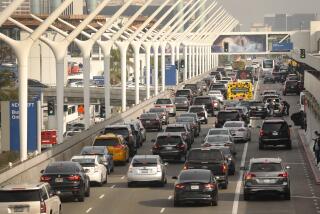‘Leave bright and early’: Southern Californians brace for crowded airports, freeways during holiday travel

- Share via
Southern Californians can expect to see high wait times at the airports and congested traffic on the freeways during the holidays this year.
And because Christmas and New Year’s days both land in the middle of the week, the weekends before the holidays are expected to be the busiest times to travel.
But the good news for road warriors is that gasoline prices are down nationwide.
About 119.3 million people will travel at least 50 miles from home between Saturday and Jan. 1 using all modes of transportation, according to the American Automobile Assn. About 107 million travelers — or 90%— are expected to be driving to their destinations, which is 2.5 million more than last year.
This year’s overall travel projection breaks the last record travel set in pre-pandemic 2019 by 64,000 people, according to AAA. The agency expects 3 million more travelers this holiday season than last year.
“This is the time of year when lifelong memories are made with loved ones, and travel plays a big role in that,” said Stacey Barber, vice president of AAA Travel. “This year, with Christmas Day falling on a Wednesday, we’re anticipating record-breaking travel numbers the weekend before and the weekend after the holiday.”
Opinion: As Christmas and Hanukkah coincide, is it time for everyone to let there be holiday lights?
Many Jewish people avoid such displays because of their association with the Christian faith. But there is an ecumenical case to be made for embracing the tradition.
Interstate 10 from Los Angeles to Palm Springs is expected to take two hours and 53 minutes on Sunday if travelers leave around 7:45 p.m. — an 81% increase from the typical drive time, according to a news release from AAA .
The 113-mile trek from San Diego to Palm Springs could take more than three hours on Friday if drivers leave around 6:15 p.m., according to AAA.
For the Bay Area, it could take up to three hours to travel from San Francisco to Sacramento using Interstate 80. From San Francisco to Napa, it’s expected to take nearly two and a half hours for travelers who leave Dec. 21, which is an 82% increase from the typical drive time.
“With a near record number of auto travelers expected this holiday season, drivers should expect delays in and around major metro areas, with Sunday, December 22 expected to be the nation’s worst day to travel,” Bob Pishue, transportation analyst at INRIX, said in a AAA news release. “Our advice is to avoid traveling during peak commuting hours during the week. If schedules allow, leave bright and early or after the evening commute.
Gas prices are expected to be lower this year compared with last year, when the national average was around $3.12, according to AAA. Demand for gas tends to decrease in December due to the frigid temperature, more remote work and the rise of online shopping. The national average as of Friday is $3.05 per gallon, according to the Auto Club. In Los Angeles, it is $4.36 per gallon, down from $4.70 a year ago.
Los Angeles is one of the cities with the highest rental demand for the holidays, with the busiest days for car pickup being Dec. 20 and Dec. 21, according to AAA car rental partner Hertz.
Northern California is expected to see a series of atmospheric river storms beginning over the weekend that could further complicate holiday travel.
“It’s going to be pretty messy, especially Monday and Tuesday if you’re trying to travel during those days,” National Weather Service meteorologist Dial Hoang said. “In the North Bay especially, we expect pretty intense rain, increased flooding concerns and possibility for damaging wind gusts, mainly at the coasts and higher elevations.”
More to Read
Sign up for Essential California
The most important California stories and recommendations in your inbox every morning.
You may occasionally receive promotional content from the Los Angeles Times.












